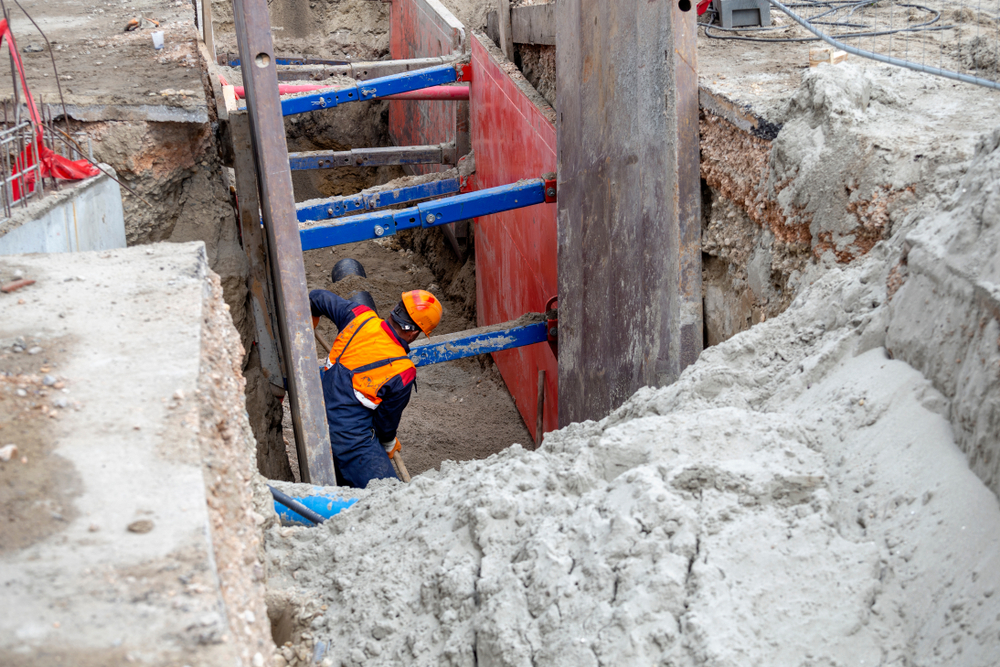This week two construction workers lost their lives during an accident at New York’s JFK International Airport. As of this writing, the news is still a developing story so details are scarce, but what is known is that the workers were buried and trapped under rubble when the trench they were working in collapsed. It took over an hour for rescuers to extract the workers, who were pronounced dead at the scene.
Construction has long been ranked one of the most dangerous industries in the world, and the fatalities at JFK Airport are a prime example of why. Construction is a multifaceted business, with projects that can expose employees to dozens of different hazards depending on the work being done. One type of hazardous work that is often forgotten about is trenching.
Per OSHA, in 2022 at least 39 construction workers died in trench mishaps. The Bureau of Labor Statistics reports that from 2011 to 2018, there were 166 trench collapse fatalities. Clearly, construction employers need to take this particular worksite hazard very seriously in order to protect workers. So let’s do a quick overview of what trenching is and how companies can mitigate risk and protect employees operating in trenches.
What Is Trenching?
Construction trenches are a specific—and very dangerous—type of man-made excavation below the surface of the ground. Such trenches tend to be long, narrow, and deep, making them inherently unsafe due to the risk of cave-ins. They’re used for different reasons, typically for laying pipes, sewer lines, or cables.
Trenches are dug out from the ground by backhoes or trenchers (which, from the side, often resemble giant chainsaws or buzzsaws). Trenches can be dug out in one of four main shapes: straight, sloped, benched, or bell-bottom pier hole.
Straight trenches may be considered the most dangerous shape in terms of cave-in risks, but all trench types are risky because soil is structurally unstable. It’s liable to shift at any time and one movement can cause the whole “house of cards” to come tumbling down. This not only puts lives on the line but can create secondary hazards such as burst pipes, flooding, muddy conditions, and chemical exposure.
Given that a cubic yard of soil “can weigh as much as a car,” it’s no wonder why OSHA writes in its Trenching and Excavation Standard that “An unprotected trench can be an early grave.” But what is trench protection?
Trench Protection Methods
As mentioned, there are different trench shapes, and creating a sloped trench counts as one form of protection. The slopes decrease the potential for dirt to pile up in the cave-in and make it a bit easier to get workers out in an emergency.
Soil types are another factor, and supervisors must be very familiar with the type of soil being dug into. Apart from stable rock, cohesive and non-fissured Type A soils (like clay) are the safest. Type B (such as angular gravel) or Type C (granular soil such as loamy sand) are less stable and thus more dangerous for trench work.
For unstable soils, additional protective measures to consider using include:
- Shoring and bracing – the use of timber or steel plate supports to help stabilize a trench wall, sometimes in conjunction with hydraulic pistons.
- Trench shields – box-shaped steel or aluminum structures in which workers can fit inside and stay safe in the event of a trench wall collapse.
Foremen can take additional safety precautions such as ensuring no nearby heavy equipment is potentially stress-loading trench walls. Nearby vehicles causing vibrations are another source of risk as the vibrations can easily travel through the ground and destabilize the soil.
Regardless of how safe a trench may seem to be, it’s vital to perform regular inspections to see that nothing has changed over time. This is even more imperative during periods of inclement weather since damp conditions can rapidly cause trench walls to erode and become unstable. Meanwhile, wet, muddy trenches increase the risk of slipping and falling, making an already hazardous work environment even more so.
Foremen should always check the weather, conduct routine trench inspections, train workers on appropriate safety protocols, and ensure suitable protective gear is available and being used accordingly.
Trench Hazards
Cave-ins are the greatest peril to trench worker safety. As mentioned, a single cubic yard of dirt weighs around 2,150 lbs and gravel can weigh even more, up to one and a half tons. It’s easy to see how a trench collapse can not only quickly bury and trap a worker, but even crush limbs and bones, making it next to impossible for them to escape.
The sheer weight of such collapses can cause water, sewer, and chemical-carrying pipes to burst, allowing their contents to flood into the soil. For trapped workers, such flooding can spell a death sentence as it adds to the weight of the soil and potentially drowns or otherwise suffocates them. In some cases, such as the 2016 double fatality incident in Boston, flooding can be deadly when a water main breaks, even if the trench itself doesn’t collapse.
To learn more about trench safety, check out the Department of Labor’s 5 Things You Should Know to Stay Safe in a Trench video.
Also visit OSHA’s Trenching and Excavation webpage for additional resources, and review the agency’s National Emphasis Program on Trenching and Excavation instruction, created “in response to the continuing incidence of trench/excavation collapses and accompanying loss of life.”




